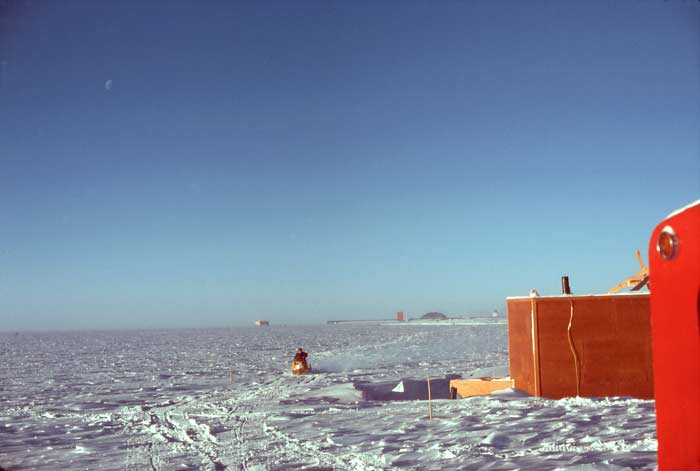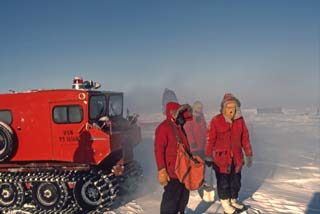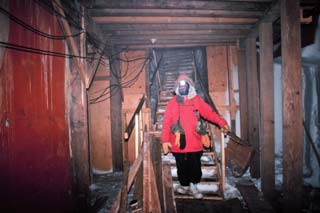Old Pole...
|
According to the account in Paul Siple's book, the then-new IGY station at the South Pole was formally dedicated and named the "Amundsen-Scott IGY South Pole Station" on January 23, 1957. This was a massive PAO event with many speeches, messages from President Eisenhower and other international heads of state, and Marines in full dress uniform. Oh, by the way, the dedication ceremony was held at McMurdo. The folks at Pole never even knew about it until the next flight three weeks later... Now, as to the above photo...we are on top of Old Pole before going in; this view looks back toward the dome. During our summer season the place was not yet off limits. We still had many official reasons to visit--moving supplies, salvaging science stuff, dismantling antennas, and operating the cosray lab to collect baseline data. Partly to make sure that we could respond to any emergency situations over there, I had $10 tours from former residents Bill Smythe and Paul Rydelek of UCLA. Paul wintered here in 1974 and Bill lived here during the 74-75 summer.
At right, a few of us on top just before going in. I don't recognize the guy with the bag, but to his right are John and Craig, it looks like Dave in the background. These first two pictures are mine. 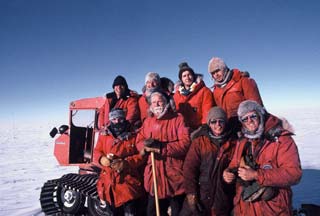
Jim and Dave were summer GFA's, Fred Kahl was the McMurdo cosray guy who was down to help Marty Pomerantz and Stu set up the new cosray equipment. It looks like I wasn't along on this work detail. This and the next 3 photos are from Les Rohde, who was one of the McMurdo sattrack people. 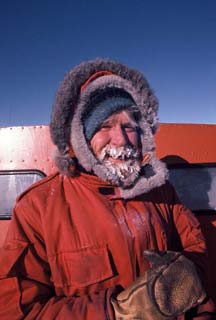
At right is the late Emmett Herbst, the H&N manager who hired me. He first contacted me at 0800 on a Monday morning in early 1976 while I was at Stanford getting my masters degree in civil engineering. I didn't have any morning classes on Monday, so I'd pulled an all-nighter to work on a project, and I had just gone to bed. The first thing he said after introducing himself was to ask me if I wanted to be the South Pole station manager. Needless to say I was instantly very wide awake. I really liked Emmett, he was a very good manager. 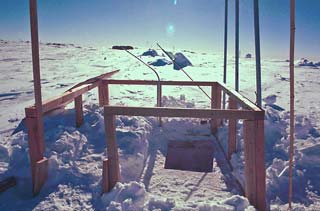
At left is the top of the "holy stairs" vestibule, which had been the main personnel entrance to the station. We are looking south, the door is directly in front of us, but we didn't know it at the time. The skiway side of the vestibule is to the right (west) side of the vestibule where the flagpoles are...remember that the skiway for the IGY station was on the far side of the old station from the present skiway. The stairway into the station descended to the left (east). Here's Franz Lazi's 1973-74 hero shot which shows the door and a little "entrance" sign pointing to it... unfortunately that sign was gone in 1976 and we wasted a lot of time digging looking for the door, which of course was on the fourth side that we dug out. Actually this entrance drifted up quickly, and we usually used one of the emergency escape ladders for access, as they did not require any digging. More recently the top end of this stair structure was equipped with one of those excess dome escape hatch manhole extension culverts with a ladder inside and a sealed cover. By the time that was yanked out in March of 2009, even that was buried 8-10 feet deep. 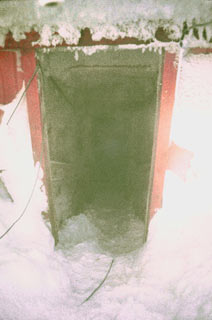 At right, we are inside the vestibule looking down the stairs. The top portion of the stairwell as seen here was of timber construction. 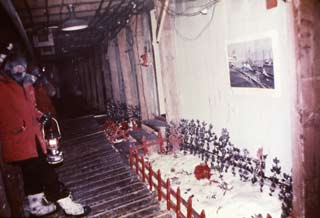
Here's Dave Thelander next to one of those famous picket fences, these red ones were in front of the south entrance to the old galley until a few years ago, later they were in the dome in front of...the southeast entrance of the old galley(!) ah progress, I think this was packed up for retrograde or trash with the rest of the old galley. Elsewhere in these tunnels are white picket fences...someone must have been into gardening.This was a hard place for us to take pictures since it was always -60°F with difficult lighting conditions. 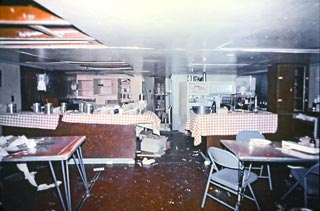 The galley building had met offices (labelled "W.B" for weather bureau on the map) at one end, with the "rawin" dome (tracker for the weather balloons) above them. The fiberglass dome (and probably the tracking antenna as well) were relocated to the BIT at our station. As far as the dining room is concerned, where is the house mouse when you need him? In 1977 all of the buildings including this one appeared to be structurally sound, with level floors. These buildings were constructed of the same "T5" panels used at McMurdo and other original IGY stations (I also saw some of these panels at Thule and Camp Tuto in Greenland)--they were two layers of wood with windows and insulation, prefabricated with metal clips to hold the panels together. The total thickness of the panels was only about 6" so you can imagine how good the insulation was. Anyway, during the winter when the station was "closed" the temperature from all of the oil-fired heaters in the buildings would raise the tunnel temperatures to +20°F or warmer and melting of the snow above the roofs became a real problem. During the summer when the tunnel exits were dug out the tunnel temperature was usually below 0°F. After the heat was turned off in the fall of 1975, the snow cover hardened and settlement decreased. But it did not stop. When I next visited this room in 1988 the floor was buckled upwards. 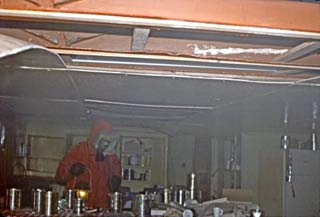
At right, Craig contemplates the leftovers. We did find some welcome additions to our menu, along with pots, pans, juice machines and other goodies. We left the frozen eggs behind, and some are still there. I've seen the more recent photos and video of scenes such as this one. It is very strange to realize that the place was "frozen in time" (sorry). It still looked like this up until the day it was collapsed (well, except perhaps for the graffiti. In our days this place was still basically a part of the local neighborhood workplace and we didn't write on the walls). Yes, I know this photo is too dark...remember this was 1976 and I got to see it about a year later...a bit too late to take a couple more shots. 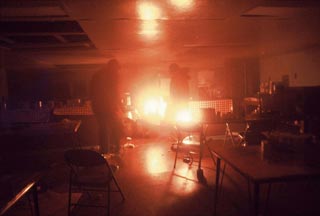 Here's Les Rohde's view of this venerable establishment. 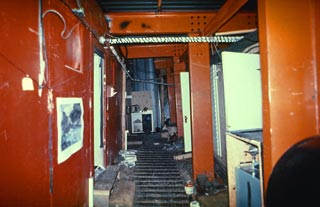
Some of the more strongly reinforced tunnels. Originally the buildings were built on the surface, and light wood and cloth coverings were added to create the tunnels. Gradually over time these got reinforced and rebuilt. Here we are looking north between sickbay (door on the left) and the OIC/store building on the right. The steel structural members were installed between the galley and the sickbay and Taj Mahal buildings in 1963-64; the OIC/store building was constructed in this space in 1969-70. Where are we...have a look at the site plan... |
